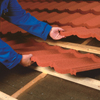
Decra roof tiles and underlays set industry benchmark
BS 5534 provides the industry with guidance on best practice relating to the installation of pitched roofs, as well as the changes to the standard focus on improving the security of the roof structure. Three elements of the standard have been revised – fixing, mortar bedding and underlays.
Decra roof tiles and underlay products are designed in line with the revised BS 5534 Code of Practice.
Fixing and mortar bedding
In terms of fixing, an update to wind load calculations means that with all single lap tiles installers will have to fix mechanically.
In addition, it is now deemed insufficient to use mortar as a sole means of fixing roof tiles, therefore tiles bedded with mortar must also be accompanied by a mechanical retraint.
Icopal’s Decra roof tile system meets the fixing element of BS 5534 fully, as the system places no reliance on dead weight to provide resistance against wind uplift.
Instead, the roof tiles are secured through both top and bottom edges into battens. As a result the tiles provide the highest resistance to wind uplift.
Lightweight underlays
With lightweight underlays now commonplace, BS5534 requires that these are securely installed and dependent on the exposure of the roof to wind uplift, batten gauge and the underlay selected it may be necessary to seal the lap of underlay.
The Monarperm range of underlays from Icopal help fulfil the requirements outlined under BS5534.
Daniel Tucker of Icopal Technical Services Department commented: As a company, we have worked hard to provide products that really help guide best practice within the industry and both our Decra and underlays are great examples of these.
The amendments to BS 5534 cover points that Icopal has recognised as hugely important for some time and we really welcome them.
Latest news

25th April 2024
ADSA: Competence Initiative Makes Progress
The Joint Competency Initiative (JCI), in which the Automatic Door Suppliers Association (ADSA) is involved, is finalising its first framework for installers within the door, gates and shutter industry.
Posted in Access Control & Door Entry Systems, Architectural Ironmongery, Articles, Building Associations & Institutes, Building Industry Events, Building Industry News, Building Products & Structures, Building Regulations & Accreditations, Building Services, Continuing Professional Development (CPD's), Doors, Facility Management & Building Services, Health & Safety, Innovations & New Products, Publications, Research & Materials Testing, Restoration & Refurbishment, Retrofit & Renovation, Security and Fire Protection, Site Preparation
25th April 2024
BMBI: Value sales in first two months were -3.4% down
The latest Builders Merchant Building Index (BMBI) report shows builders’ merchants’ value sales were down -4.7% in February compared to the same month a year ago.
Posted in Articles, Bathrooms & Toilets, Bathrooms, Bedrooms & Washrooms, Bricks & Blocks, Building Associations & Institutes, Building Industry News, Building Products & Structures, Building Services, Civil Engineering, Concrete, Cement, Admixtures, Drainage, Floors, Hard Landscaping & Walkways, Interior Design & Construction, Interiors, Landscaping, news, Paints, Paints, Coatings & Finishes, Plant, Equipment and Hire, Plumbing, Posts, Publications, Research & Materials Testing, Restoration & Refurbishment, Retrofit & Renovation, Sustainability & Energy Efficiency
24th April 2024
The lowdown on Origin’s New Soho Offering
Origin’s Soho External Door is the first launch in its new generation of products, setting a higher standard for the fenestration industry.
Posted in Access Control & Door Entry Systems, Aluminium Products, Architectural Ironmongery, Articles, Building Industry News, Building Products & Structures, Building Systems, Doors, Innovations & New Products, Posts, Restoration & Refurbishment, Retrofit & Renovation, Security and Fire Protection
24th April 2024
Mitsubishi Electric welcomes new code of conduct for smart appliances
Mitsubishi Electric welcomes a new code of conduct on energy smart appliances which the European Union (EU) announced yesterday at the Hannover Fair in Germany.
Posted in Air Conditioning, Articles, Building Industry Events, Building Industry News, Building Products & Structures, Building Regulations & Accreditations, Building Services, Exhibitions and Conferences, Facility Management & Building Services, Heating Systems, Controls and Management, Heating, Ventilation and Air Conditioning - HVAC, Plumbing, Retrofit & Renovation, Seminars, Sustainability & Energy Efficiency
 Sign up:
Sign up: